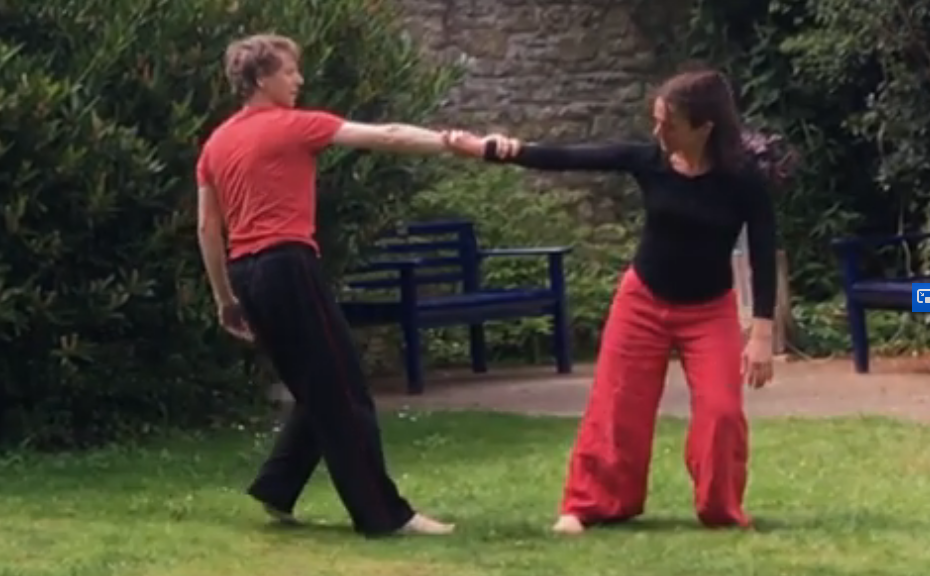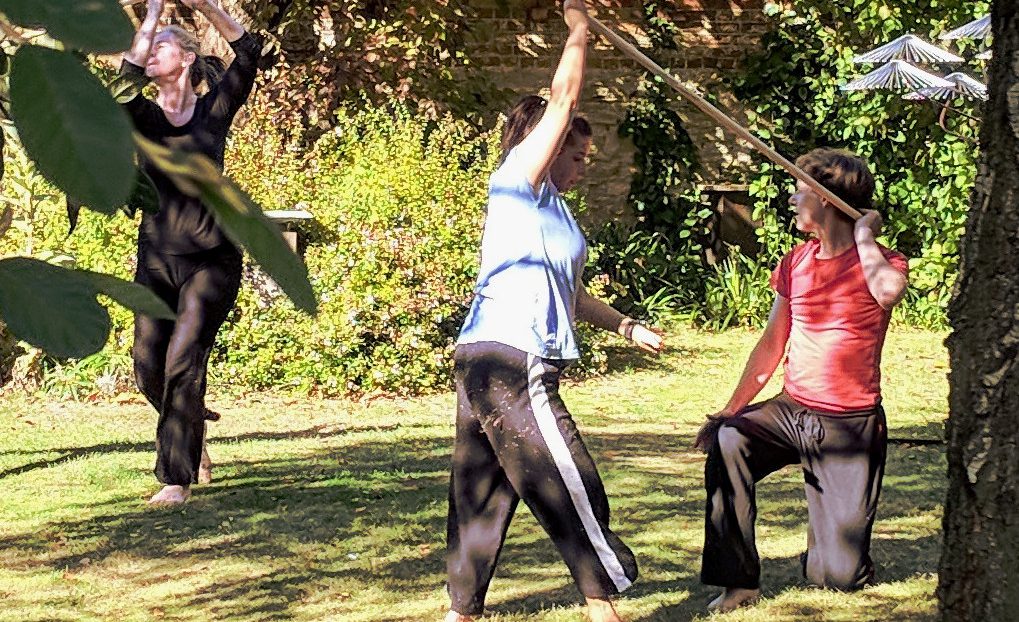In an age of coronavirus (July 2020) with the need to avoid bodies in contact, we can have some contact with each other through the use of artefacts like – balls, ropes, fabrics, sticks or poles. We can ‘contact-through’ them to other dancers while dancing outside. This article includes Government guidelines about reducing infection risks.
Balls!
Contact through the passing of a ball. So netball, football and basketball then? Perhaps – and they are movement practices. It’s mostly the protocols – rules – which create different outcomes – the balls are very similar in the listed sports. But we can create our own movement practice with one or more balls, composition and improvisation. Often we start a dance session by throwing a ball between us, saying our names as a ice-breaker.
Tethering

When Contact Improvisation Dance in Bristol met at Brandon Hill Park on 2 June 2020, they improvised dance using tethering – cords and fabrics which allowed them to feel the presence of other bodies while maintaining at least a 2 metre distance.
In more normal times without restrictions on contact, we might tether by hand holds and contra-balancing – shown in this photo below.

Bridging
Sticks and poles allow us to reach out and touch but without direct contact in our bodies. Their rigidity allows the giving of weight as well as counter-balance.
Bruce Curtis (You Tube playlist) and Charlene Curtiss created this exquisite dance with a bamboo pole and their two wheelchairs in 1997. The dominant motifs are the circles of the four wheels and the line of the bamboo pole.
At Oxford Contact Dance in 2018, we created a performance – The Garden Dance – using wooden sticks/poles and techniques from Contact Improvisation. See photo below.

Techniques from martial arts like Aikido which use sticks – the short staff (jō) – could also be inspiration for dancing – although some movements require close proximity. Seeing these Aikido techniques with sticks, I wonder: are we primarily moving our bodies and the stick following the movement or are we primarily moving the stick? Where does the movement start? Is the stick an extension of a limb – or something else?
We should look to other traditions of dancing with sticks … like this Morris dancing in Botley near Oxford (‘English folk dance’). Admittedly, more pedestrian than the dynamic movements of Aikido … but let’s take inspiration where we can find it.
Coronavirus/COVID-19 considerations
It’s considered good practice to write a risk assessment – even a cursory one – when organising events especially in relation to coronavirus/COVID-19.
The UK Government provide guidance for England (Guidance for providers of outdoor facilities on the phased return of sport and recreation in England – Updated 30 June 2020) and the devolved administrations provide further guidance for their regions.
Here, I draw-out guidance applicable to dancing outside, social distancing and with artefacts to contact-through. This article by Dr Jonathan Fluxman is recommended if you want more depth: ‘It’s not only about social distancing: the importance of airborne spread of Covid-19′. This article from the BBC discusses what is law and what is guidance in England in relation to COVID-19 and it’s quite a complicated situation!
The England guidance describes ‘Principles to help organisations prepare for a phased return to play’:
Working to ensure the activity can meet public health guidelines
All activity should be consistent with the government guidance regarding health, social distancing and hygiene.
That means that participants and others can follow social distancing guidelines, that good hygiene practices are in place, that equipment is disinfected regularly, and that it is clear that anyone who is symptomatic or suspects they have been exposed to the virus does not take part and remains at home.
Consider the whole end-to-end ‘user journey’ when planning safe operating practices; this means all activities from the time of arrival on site to leaving, not just the sporting activity.
Guidance for providers of outdoor facilities on the phased return of sport and recreation in England – Updated 30 June 2020
Record keeping
Organisers are expected to keep records of those attending and contact details:
Keep a ‘temporary record of your customers and visitors for 21 days, in a way that is manageable for your business, and assist NHS Test and Trace with requests for that data if needed. This could help contain clusters or outbreaks.
Guidance for providers of outdoor facilities on the phased return of sport and recreation in England – Updated 30 June 2020
Hygiene
The Government guidance notes:
Cleaning protocols should be put in place to limit coronavirus transmission in public places. It is advised that touch points (e.g. handrails and gates) should be particular areas of focus for increased cleaning.
Guidance for providers of outdoor facilities on the phased return of sport and recreation in England – Updated 30 June 2020
Therefore, objects which we might ‘contact-through’ should be cleaned frequently to avoid being vectors for the transmission of the virus. Similarly, asking dancers to wash their hands or use hand sanitiser frequently may reduce transmission through surfaces which are handled ie objects which are shared points of contact.
Social distancing
The Government guidelines suggest that dancers could dance as close as 1 metre to each other if they have additional mitigations such as a face coverings. Otherwise without this, its only 2 meters or more between dancers.
Social distancing guidelines should be followed between people from different households wherever possible. From 4 July, this means a distance of 2m between people from different households, or 1m plus mitigations (such as face coverings or avoiding face-to-face contact) where 2m is not possible.
Guidance for providers of outdoor facilities on the phased return of sport and recreation in England – Updated 30 June 2020
Number of participants
In a group of people exercising or dancing together then the group should be no more than 6 people from different households. The Government guidance says:
The government is clear that sports participation should be restricted to participants exercising by themselves, with members from their same household, or in a group of no more than 5 other people from other households, while observing social distancing guidelines.
Guidance for providers of outdoor facilities on the phased return of sport and recreation in England – Updated 30 June 2020
Featured Image
Photograph (Violette Aubry – used with permission): Contact Improvisation in Bristol. Brandon Hill Park, Bristol – 2 June 2020.
